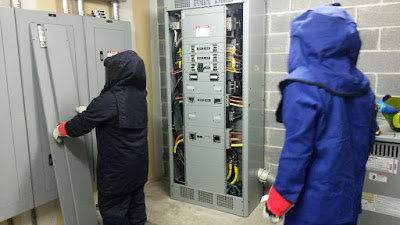Many safety leaders have stated
that they do not allow qualified employees to work on or near exposed live
(energized) circuits. They have created
a policy that all energized circuit shall be de-energized and locked and tagged
(LOTO) per specific control of hazardous energy policies. This is a great policy, but it is not always
feasible.
There are some systems that
cannot be easily de-energized. OSHA's requirement for working on energized equipment is “Live parts to which an
employee may be exposed shall be deenergized before the employee works on or
near them, unless the employer can demonstrate that deenergizing introduces
additional or increased hazards or is infeasible due to equipment design or
operational limitations” [OSHA 29 CFR 1910.333(a)(1)].
 Electrical systems that are
identified as emergency systems (NFPA 70, Chapter 700), legally required
systems (NFPA 70, Chapter 701), and critical operating power systems (NFPA 70,
Chapter 708) cannot be de-energized unless permission is obtained from the
appropriate governmental authority have jurisdiction (AHJ). Emergency power systems are critical for life
safety and include many healthcare facilities.
Emergency power systems are also located in every public building and
include emergency lighting for egress and fire suppression, alarm, and
communication circuits. Legally required
power systems include those systems that if de-energized, can create a greater
hazard to the community. Legally
required power systems include those systems that control pollution abatement
systems, chemical containment systems, and the like. Critical operating power systems include
those systems that critical to functionality of the US. This includes water, transportation, energy,
transportation, and specific monetary functions.
Electrical systems that are
identified as emergency systems (NFPA 70, Chapter 700), legally required
systems (NFPA 70, Chapter 701), and critical operating power systems (NFPA 70,
Chapter 708) cannot be de-energized unless permission is obtained from the
appropriate governmental authority have jurisdiction (AHJ). Emergency power systems are critical for life
safety and include many healthcare facilities.
Emergency power systems are also located in every public building and
include emergency lighting for egress and fire suppression, alarm, and
communication circuits. Legally required
power systems include those systems that if de-energized, can create a greater
hazard to the community. Legally
required power systems include those systems that control pollution abatement
systems, chemical containment systems, and the like. Critical operating power systems include
those systems that critical to functionality of the US. This includes water, transportation, energy,
transportation, and specific monetary functions. Another type of power system is the optional power systems (NFPA 70, Chapter 702). Optional (nonessential) power systems are those systems and loads that are related to business continuity. These power systems can be de-energized without creating safety hazards, although they may impact the business.
In addition to systems that
cannot be de-energized easily because of legal requirements, specific activities
such as troubleshooting, testing and measuring of voltage, current, power or
related parameters must be conducted when electrical equipment is energized on all types of power systems [NFPA 70E-2015, Chapter 130]. There are
other activities that may also require qualified personnel to interact with
exposed live (energized) circuits. This
includes the adjustment and programming of equipment. These activities can be conducted on all types
of electrical systems and in locations such as manufacturing environments,
R&D laboratories, production testing environments, and many more.
Last month’s blog focused on the
Administrative Methods of hazard reduction and mitigation of electrical
hazards. While administrative methods
can be effective, they also present an opportunity for injuries to occur. Hazard reduction and mitigation techniques
are more reliable and effective when Engineering Methods are implemented.
The Engineering Methods of hazard
reduction and mitigation of electrical hazards include:
- · Elimination
- · Substitution
- · Guarding
- · Safety Control Systems
Safety control systems are
typically devoted to keep employees out of a hazardous area and can be very
loosely similar to guarding principles.
Common equipment associated with safety control systems include using
light-curtains, pressure mats, interlocks, or other components tied into a
safety rated programmable logic controller (PLC).
The substitution principle can be
used by changing the operating voltage that the qualified employee is required
to interact with. This includes changing
control voltages from 120V or 240V to 24V.
The 24V control circuit can be located in a separate cabinet that is
isolated from any circuit that is 50V or greater. Qualified employees working on system
voltages of 24V are generally not exposed to shock or arc flash hazards.
 To eliminate electrical hazards,
designers and engineers can remove the need for people to interact with exposed live
(energized) circuits. This includes
designing equipment such that user interface equipment is located on the front
panel of the equipment. Examples include
using HMI’s, remote panels for SCRs or other industrial control components,
remote communication interface ports, etc.
Eliminating qualified personnel from interacting with exposed live
(energized) circuits can be achieved on new equipment that is in the design
phase, but is not very practical for equipment that is already installed.
To eliminate electrical hazards,
designers and engineers can remove the need for people to interact with exposed live
(energized) circuits. This includes
designing equipment such that user interface equipment is located on the front
panel of the equipment. Examples include
using HMI’s, remote panels for SCRs or other industrial control components,
remote communication interface ports, etc.
Eliminating qualified personnel from interacting with exposed live
(energized) circuits can be achieved on new equipment that is in the design
phase, but is not very practical for equipment that is already installed.








